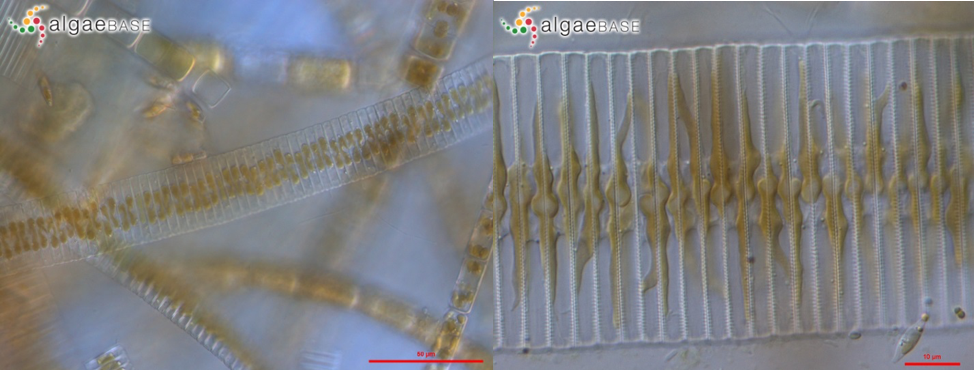|
By Eli Gendron Diatoms are a unique life form that can be found in a wide range of environments, from the soils of the arctic and the some of the highest mountains in the world to freshwater lakes across the globe and throughout our oceans (Mann & Droop 1996). One of the characteristics that make diatoms so unique is the glass like shell they build out of silica which often leads them to have regular geometric shaped cells (see Figure 1). These single celled organisms often form colonies that take many forms such as the chains seen in Figure 1. Diatoms are almost always photosynthetic but several strains have been found to be capable of mixotrophy and heterotrophy, meaning they are capable of living off organic matter (Villanova et al. 2017; Tan & Johns 1996).  Figure 1. Image of Fragilaria capucina as seen under a microscope. Left: Image of Fragilaria capucina taken in Chico, Washington, USA; Chico Creek, 400x magnification, DIC – 13 Jul 2008. Right: Image of Fragilaria capucina taken in Bremerton, Washington, USA; Kitsap Lake, 1000x magnification, DIC – 11 Oct 2008. Images curated by http://www.algaebase.org/search/species/detail/?species_id=31451&distro=y#distro Diatoms such as Fragilaria capucina are a common occurrence in freshwater habitats around the world; however, they tend be low in abundance in oligotrophic (low nutrient) ecosystems. When an ecosystem is exposed to more nutrients than naturally occur, usually through pollution such as nitrogen in fertilizer run off, it becomes eutrophic (abundant nutrients) leading to blooms of previously rare organisms. Fragilaria capucina is one such diatom that is highly resistant to pollution and can often be found thriving in eutrophic conditions (Rott et al. 1998). Armed with this type of knowledge we can monitor communities of easily obtainable species to use as indicators of ecosystem status including catching pollution early. References: Mann, D.G. & Droop, S.J.M. (1996) Biodiversity, biogeography and conservation of diatoms. Hydrobiologia 336: 19-32 Rott E, Duthie HC, Pipp E. 1998. Monitoring organic pollution and eutrophication in the Grand River, Ontario, by means of diatoms. Can J Fish Aquat Sci 55:1443–1453. Tan, C.K. and Johns, M.R., 1996. Screening of diatoms for heterotrophic eicosapentaenoic acid production. Journal of Applied Phycology, 8(1), pp.59-64. Villanova, V., Fortunato, A.E., Singh, D., Dal Bo, D., Conte, M., Obata, T., Jouhet, J., Fernie, A.R., Marechal, E., Falciatore, A. and Pagliardini, J., 2017. Investigating mixotrophic metabolism in the model diatom Phaeodactylum tricornutum. Phil. Trans. R. Soc. B, 372(1728), p.20160404
0 Comments
|
AuthorVarious lab members contribute to the MoM Blog Archives
October 2023
Categories |

 RSS Feed
RSS Feed
